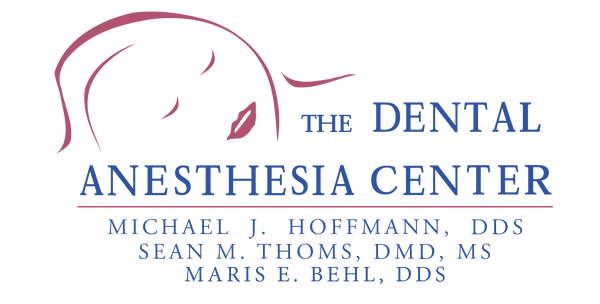We offer various dental sedation options to ensure everyone receives the care they need in a calm and comfortable environment.
At The Dental Anesthesia Center, we understand that visiting the dentist can be a stressful experience for many patients, especially children, individuals with special needs, or those with dental anxiety. To ensure everyone receives the care they need in a calm and comfortable environment, we offer various dental sedation options tailored to each patient’s unique needs.

Dental Sedation Options:
When dentists use sedation to help curb pain and anxiety during dental treatments, they use medications that allow their patients to relax. While it’s commonly referred to as “sleep dentistry,” in most instances, it doesn’t actually put the client to sleep; generally, the patient is completely awake. The only time that a patient is put to sleep is if they decide to use general anesthesia. There are four different levels of dental sedation: minimal, moderate, or conscious sedation, deep sedation, and general anesthesia.
Here are the dental sedation options available at The Dental Anesthesia Center:
Nitrous Oxide (Laughing Gas)
What it is: Nitrous oxide, commonly known as “laughing gas,” is one of the mildest forms of sedation. It is administered through a small mask placed over the patient’s nose, allowing them to inhale the gas mixed with oxygen.
How it works: Nitrous oxide helps patients relax while remaining fully conscious. It provides a calming effect, reducing anxiety and making the patient feel more at ease. The gas takes effect quickly and wears off within minutes after removing the mask, allowing patients to leave the dental office without lingering drowsiness.
Benefits:
- Safe for children and adults
- Quick recovery, allowing patients to return to their normal activities immediately
- Minimal side effects
This treatment is best for patients with mild dental anxiety, children who can follow directions, and those undergoing minor dental procedures.
Oral Sedation
What it is: Oral sedation involves taking a prescribed pill or liquid before the dental procedure to help you relax. Depending on the dosage, oral sedation can range from mild to moderate.
How it works: Oral sedation makes patients feel drowsy but still conscious, allowing them to remain awake but deeply relaxed during the procedure. Some patients may become so relaxed that they fall asleep, but they can still be easily awakened if necessary.
Best for: Patients with moderate dental anxiety or those undergoing longer or more involved procedures.
Benefits:
- Easy to administer, with the medication taken before the appointment
- It provides a deeper level of relaxation compared to nitrous oxide
- Allows patients to be responsive while feeling calm and comfortable
Considerations: Since oral sedation can cause drowsiness several hours after the procedure, patients need someone to drive them home.
IV Sedation
What it is: IV sedation is administered intravenously, delivering sedation medication directly into the bloodstream. This method allows the dentist to adjust the level of sedation throughout the procedure, providing greater control.
How it works: IV sedation induces a deep state of relaxation, and most patients do not remember the procedure afterward. Although patients are not entirely unconscious, they are in such a relaxed state that they may feel as though they are asleep. This type of sedation is often referred to as “twilight sedation.”
Best for: Patients with severe dental anxiety, those undergoing complex or multiple procedures, or individuals with special needs who require a higher level of sedation to remain comfortable.
Benefits:
- Allows for precise control over the level of sedation
- Patients typically experience little to no memory of the procedure
- Can be adjusted in real-time to maintain optimal comfort
Considerations: As with oral sedation, patients will need someone to drive them home after the procedure due to the lingering drowsiness from IV sedation.
General Anesthesia
What it is: General anesthesia is the deepest form of sedation, in which the patient is completely unconscious and unaware of the procedure. It is typically administered by an anesthesiologist in a hospital or specialized dental setting, like The Dental Anesthesia Center, where a highly trained team monitors the patient closely throughout the procedure.
How it works: Under general anesthesia, the patient is fully unconscious and cannot feel pain, move, or respond to instructions. This type of sedation is reserved for the most complex cases, including patients with extreme anxiety, individuals with certain medical conditions or special needs, and those requiring extensive dental work.
Best for: Patients with severe dental phobia, individuals with special needs or medical conditions that prevent cooperation during treatment, and those requiring extensive or invasive dental procedures.
Benefits:
- Complete comfort with no awareness of the procedure
- Ideal for patients with special needs who may not be able to cooperate during treatment
- Ensures that extensive dental work can be completed in a single visit
Considerations: Patients will need time to recover from general anesthesia and will be required to have someone accompany them home after the procedure.
Which Sedation Option is Right for You?
Choosing the right sedation option depends on several factors, including the type of dental procedure, the level of anxiety you or your child experiences, and any special medical considerations. At The Dental Anesthesia Center, our team of experienced sedation dentists will carefully evaluate your needs and recommend the most appropriate sedation option to ensure a comfortable and stress-free experience.
If you or your child struggles with dental anxiety or has special needs that make dental care difficult, sedation dentistry may be the solution you’ve been looking for. Contact The Dental Anesthesia Center today to learn more about our sedation options and schedule a consultation.

